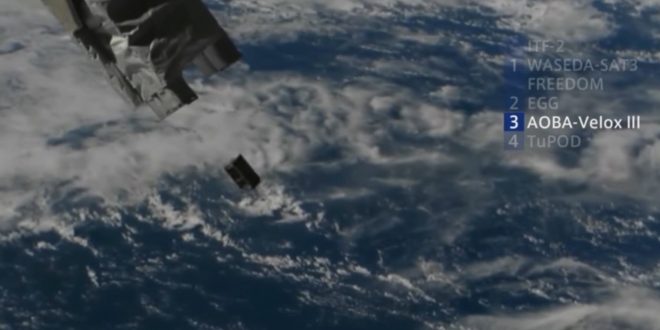Nanyang Technological University, Singapore (NTU Singapore) has successfully launched its 7th satellite into space from the International Space Station (ISS).
Named the AOBA VELOX-III, it is the first Singapore satellite to be launched from the ISS, a 110-metre habitable human-made satellite that orbits the Earth.
NTU’s satellite was delivered to the ISS last month by Japan’s national aerospace agency, the Japan Aerospace Exploration Agency (JAXA), on a resupply rocket from the Yoshinobu Launch Complex at Tanegashima Space Center, Japan.
Unlike the conventional way of launching a satellite directly into space from a rocket, the two-kilogramme VELOX-III was shot into orbit around earth using a special launcher by a Japanese astronaut at the ISS.
The AOBA VELOX-III is a joint project between NTU and Japan’s Kyushu Institute of Technology (Kyutech), one of Japan’s leading universities for satellite research and engineering.
The nano-satellite features a unique micro-thruster built by NTU, which enables the satellite to remain in space twice as long than it usually would.
Traditionally, small satellites do not have thrusters due to modest budgets and insufficient space to mount conventional thrusters used by bigger satellites. Without thrusters, satellites have no means to keep them in orbit and will gradually lose altitude.
Director of the NTU Satellite Research Centre, Mr Lim Wee Seng, said they have successfully made contact with AOBA VELOX-III, which is now orbiting 400 kilometres above Earth.
“The successful deployment of the AOBA VELOX-III is testament to the strong satellite engineering expertise at NTU. Building up the local satellite talent pool and developing disruptive technologies like the micro-thruster in the AOBA VELOX-III is important for Singapore’s budding space industry,” Mr Lim said.
“Riding on the success of the AOBA VELOX III, we are now developing our second joint satellite with Kyutech which could lead to small and manoeuvrable satellites being used as space probes in future.”
Professor Mengu Cho, Director of Kyutech’s Laboratory of Spacecraft Environment Interaction Engineering, said, “The launch of AOBA VELOX-III is the tangible result of research collaboration between Kyutech and NTU for the past three years. AOBA VELOX-III is an important milestone in the Japan-Singapore inter-university space exploration.
“We are looking forward to another joint satellite that is under development and scheduled to be launched in 2018. The long-term goal of the Kyutech-NTU joint space programme is to do a lunar mission using the technologies demonstrated by these two satellites.”
Professor Yoon Soon Fatt, Chair of NTU’s School of Electrical and Electronic Engineering, said conducting real satellite missions are key to training local talents for Singapore’s future satellite industry.
“Satellite technology is a field that requires strong expertise across several disciplines, from power systems and batteries to integrated circuits and wireless communications,” Prof Yoon said. “The actual designing, building and operating real satellites in space gives a huge boost to the learning journey of our students and is an unparalleled experience for those seeking careers in the space industry. “
Longer time in space for seventh satellite
Orbiting at 400 kilometres above sea level, the AOBA VELOX-III will be conducting several tests. This includes the made-in-NTU micro-propulsion system, a new wireless communication system developed by Kyutech and experiments to evaluate the durability of commercial off-the-shelf microprocessors in space.
NTU’s new micro-propulsion system generates a small amount of thrust using pulsed plasma, which could lift the satellite 200 metres for each hour of flight. The pulsed plasma is produced by using 1500 volts of electricity applied to Teflon, a common fuel material for satellites.
The micro-thrusters will help the satellite to remain in orbit longer as satellites lose altitude over time due to the drag caused by the surrounding atmosphere at low earth orbit. It will maintain the satellite’s speed at 27,000km/h, extending its flight lifespan to six months instead of the usual three months before it loses altitude.
Mr Lim added that these space experiments by AOBA VELOX-III will enhance the university’s satellite building capabilities, paving the way for the next generation of nanosatellites that are more advanced and reliable.
Agencies/Canadajournal
 Canada Journal – News of the World Articles and videos to bring you the biggest Canadian news stories from across the country every day
Canada Journal – News of the World Articles and videos to bring you the biggest Canadian news stories from across the country every day



